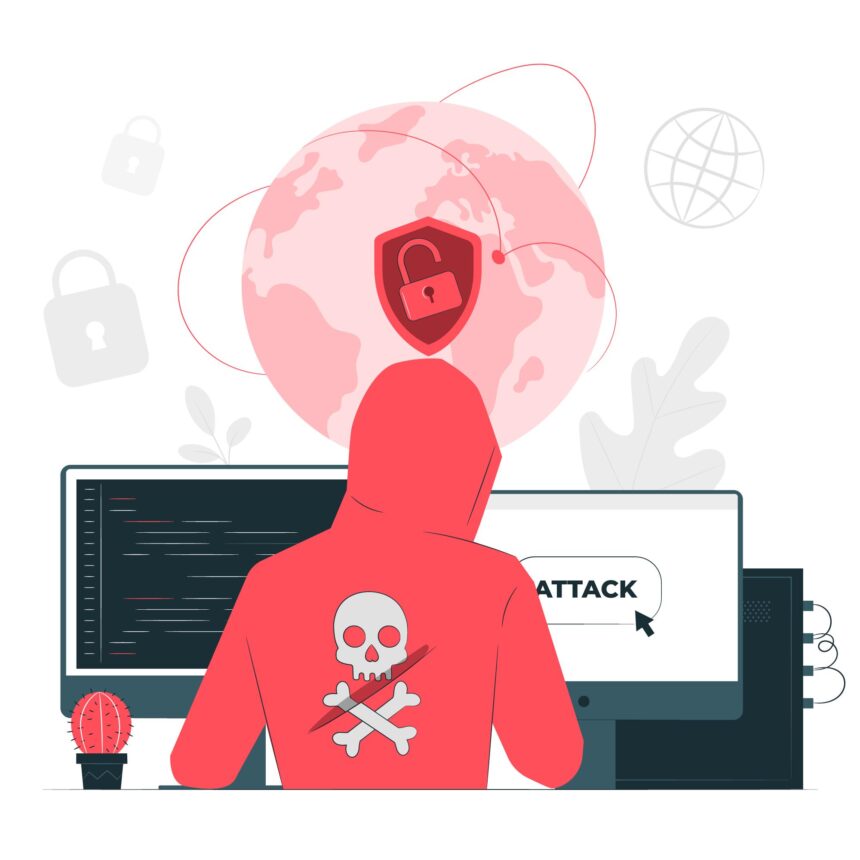In today’s digital age, businesses are more interconnected than ever, which makes cybersecurity a critical aspect of daily operations. As companies continue to rely on technology for their day-to-day functions, they also face an increasing number of cyber threats that can cause significant damage.
Whether it’s a small business or a large corporation, every organization must take the necessary steps to protect sensitive information, safeguard customer data, and ensure the overall security of their digital infrastructure.
The rise of online threats such as hacking, phishing, and malware attacks has made cybersecurity one of the most important concerns for business owners and IT professionals. A single security breach can lead to a loss of customer trust, legal consequences, and financial damage.
This article will explore some of the best practices for cybersecurity, helping businesses of all sizes protect themselves from the growing number of online threats.
The Importance of Cybersecurity in Modern Business
As technology continues to evolve, so do the methods used by cybercriminals to exploit vulnerabilities in digital systems. Cybersecurity is no longer an optional investment but a necessary one for companies that want to operate in a safe and secure environment. Business owners who fail to take cybersecurity seriously risk exposing their company to various types of cyberattacks, such as ransomware, data breaches, and identity theft.
Cyberattacks can have devastating consequences for any business. For example, a data breach could result in the loss of sensitive customer information, including personal details, financial data, and login credentials. This could lead to identity theft, fraud, and damage to your company’s reputation. Additionally, cybercriminals may use ransomware to lock your company’s data and demand a ransom for its release. In some cases, businesses may be forced to shut down temporarily or permanently due to the extent of the damage caused by a cyberattack.
To avoid such risks, businesses must implement robust cybersecurity measures that can effectively protect their networks, devices, and data from cyber threats. By adopting a proactive approach to cybersecurity, companies can reduce the likelihood of falling victim to attacks and ensure that their operations continue smoothly.
Key Cybersecurity Threats Businesses Should Be Aware Of
Before delving into the best practices for protecting your business from online threats, it’s essential to understand the types of cybersecurity risks that exist. This knowledge will help you better prepare for potential attacks and create strategies to defend against them.
1. Phishing Attacks
Phishing is one of the most common types of cyberattacks used by cybercriminals. In a phishing attack, the attacker attempts to trick individuals into revealing sensitive information such as passwords, credit card numbers, or personal identification details. This is often done by sending fraudulent emails or messages that appear to come from legitimate sources, such as banks, online retailers, or government agencies.
Phishing emails often contain links to fake websites that look identical to real ones, tricking victims into entering their login credentials or personal information. In some cases, phishing emails may include attachments containing malware or viruses that can infect the victim’s computer or network.
2. Ransomware
Ransomware is a type of malware that encrypts a victim’s files or locks them out of their systems. The attacker then demands a ransom in exchange for restoring access to the files or system. Ransomware attacks have become increasingly common, targeting businesses of all sizes, government organizations, and healthcare institutions.
In some cases, attackers may threaten to release sensitive data to the public unless the ransom is paid. Ransomware attacks can be devastating for businesses, causing data loss, downtime, and financial losses.
3. Malware and Viruses
Malware is a broad term that refers to any software designed to harm or exploit computer systems. It includes viruses, worms, Trojans, and spyware, all of which can have various negative effects on your business operations. Malware can be delivered via email attachments, malicious websites, or compromised software downloads.
Once installed on a system, malware can cause a wide range of issues, including data corruption, loss of access to critical files, and unauthorized access to sensitive information. Malware can also be used to steal login credentials or allow cybercriminals to control infected devices remotely.
4. Data Breaches
A data breach occurs when unauthorized individuals gain access to sensitive data stored by a company. This could include customer information, financial records, intellectual property, or any other confidential data. Data breaches often occur due to weak security practices, such as poorly managed passwords or outdated software.
Data breaches can lead to significant financial losses, as well as damage to a company’s reputation. In some cases, businesses may be required to notify affected customers, offer credit monitoring services, or pay for legal fees and regulatory fines.
5. Insider Threats
Not all cyber threats come from external sources. Insider threats occur when an employee, contractor, or business partner intentionally or unintentionally compromises the security of the company’s data. This could involve stealing sensitive information, mishandling data, or falling for phishing scams that lead to a breach.
Insider threats can be difficult to detect because they often involve individuals who already have authorized access to the company’s systems. As such, businesses must implement strict access controls and monitoring practices to detect any suspicious activity.
Best Cybersecurity Practices for Protecting Your Business
Now that we have a better understanding of the types of cyber threats businesses face, let’s explore some of the best practices for cybersecurity that can help protect your business from these online dangers.
1. Implement Strong Password Policies
One of the simplest and most effective ways to protect your business from cyberattacks is by enforcing strong password policies. Passwords are the first line of defense against unauthorized access to your systems and data. Weak passwords are easy for attackers to guess or crack, making them an attractive target for cybercriminals.
To strengthen your password policies, ensure that all employees use complex passwords that include a combination of uppercase and lowercase letters, numbers, and special characters. Additionally, encourage employees to change their passwords regularly and avoid using the same password across multiple accounts.
Consider using multi-factor authentication (MFA) to add an extra layer of security. MFA requires users to provide two or more forms of identification before accessing sensitive systems, such as a password and a fingerprint scan or one-time code sent to their mobile device.
2. Keep Software and Systems Up to Date
Outdated software and operating systems are a common target for cybercriminals. Software developers frequently release updates and patches to fix vulnerabilities and improve security. Failing to install these updates can leave your business exposed to cyberattacks.
Ensure that all software and systems are up to date, including operating systems, web browsers, antivirus programs, and any other applications used by your business. Enable automatic updates whenever possible to ensure that security patches are applied promptly.
3. Regularly Back Up Your Data
Data loss can occur for many reasons, including cyberattacks, hardware failures, or accidental deletion. To minimize the impact of data loss, businesses should implement a regular backup routine. Backups should be stored securely and easily accessible in the event of a disaster.
Consider using a combination of on-site and off-site backups, such as cloud storage, to ensure redundancy. Test your backup systems regularly to ensure that data can be recovered quickly and efficiently if needed.
4. Train Employees on Cybersecurity Awareness
Employees are often the weakest link in a company’s cybersecurity defenses. Cybercriminals frequently target employees with phishing emails or other social engineering tactics to gain access to sensitive information.
To reduce the risk of human error, provide regular cybersecurity training to all employees. This training should cover topics such as identifying phishing emails, avoiding suspicious links and attachments, and understanding the importance of strong password practices. Encourage employees to report any suspicious activity they encounter to the IT department immediately.
5. Use Firewalls and Antivirus Software
Firewalls and antivirus software are essential tools for protecting your business from online threats. Firewalls act as a barrier between your internal network and the internet, filtering out malicious traffic and preventing unauthorized access to your systems.
Antivirus software helps detect and remove malware from your devices before it can cause damage. Ensure that all devices used by your employees, including computers, smartphones, and tablets, are equipped with up-to-date antivirus software.
6. Encrypt Sensitive Data
Data encryption is a powerful tool for protecting sensitive information. Encryption converts data into an unreadable format that can only be decrypted with a specific key. By encrypting sensitive data, you can ensure that even if it is intercepted during transmission or stolen, it remains unreadable to unauthorized individuals.
Encrypt data both at rest (stored on your systems) and in transit (transmitted over the internet). This is especially important for businesses that handle sensitive customer information, such as credit card numbers, health records, or personal identification details.
7. Conduct Regular Security Audits and Penetration Testing
To ensure that your cybersecurity measures are effective, it’s essential to conduct regular security audits and penetration testing. Security audits involve reviewing your business’s cybersecurity practices to identify any weaknesses or gaps in your defenses. Penetration testing involves simulating a cyberattack to assess how well your systems can withstand an actual attack.
By regularly testing your security measures, you can identify potential vulnerabilities and take corrective actions before a real attack occurs.
Conclusion
Cybersecurity is a critical concern for businesses in today’s digital world. With cyber threats becoming more sophisticated and widespread, it’s essential for companies to adopt best practices to protect their networks, data, and reputation.
By implementing strong password policies, keeping software up to date, training employees, and using firewalls and encryption, businesses can significantly reduce their risk of falling victim to cyberattacks.
Cybersecurity is not a one-time effort but an ongoing process that requires constant vigilance and adaptation. As new threats emerge, businesses must stay informed and update their security practices accordingly. By following the cybersecurity best practices outlined in this guide, businesses can build a strong defense against online threats and ensure their continued success in the digital age.

